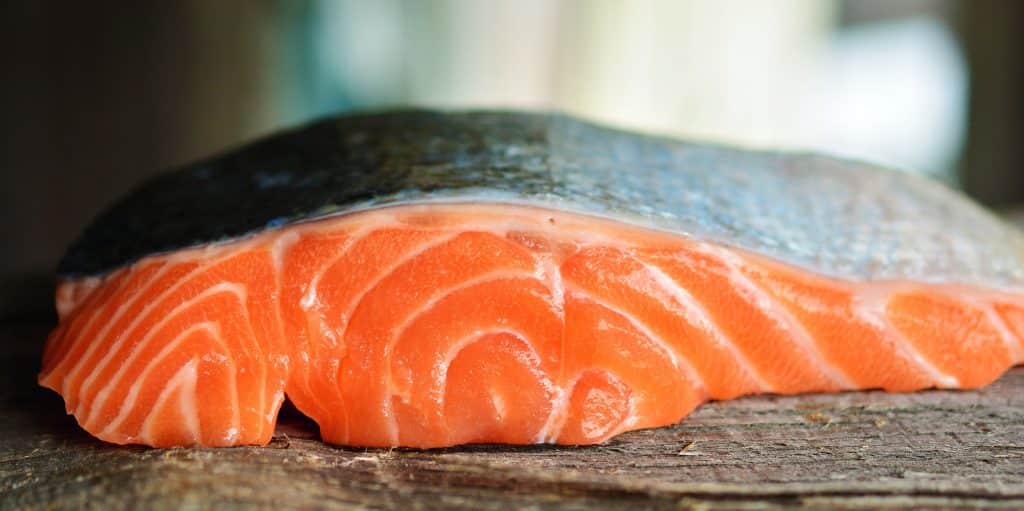Can Dogs Eat Salmon Skin? A Vet’s Opinion

Salmon is an excellent source of protein, but can you feed Salmon Skin to your dog?
Dogs can potentially eat salmon skin. However, it is typically not advised. Salmon skin contains a lot of fat, which can be challenging for dogs to digest in enormous quantities and may result in digestive problems like diarrhea or vomiting.
Benefits Of Salmon Skin For Dogs
Although it’s generally advised against giving dogs salmon skin because of the hazards connected to its high-fat content and the existence of bones or scales, there are a few potential benefits to take into account:
- Salmon skin is a good source of omega-3 fatty acids, necessary fats to maintain the health of a dog’s skin and coat. According to research, omega-3 fatty acids can help dogs have healthy skin and a lustrous coat by acting as anti-inflammatory agents.
- Protein is a crucial ingredient that dogs require for a variety of physiological activities, including muscular growth, healing, and maintenance. Salmon skin is a good source of protein. For a dog’s general health and wellbeing, protein is crucial.
- Salmon skin may be palatable to some dogs, who love the flavor and texture. This can make it a tempting treat for dogs, especially those that like fish-based diets.
- Offering cooked, skinless, and boneless salmon in tiny portions as an occasional treat can add some nutritional variety to a dog’s diet. To minimize potential hazards, it’s crucial to ensure the salmon is cooked and prepared correctly.
- Tooth Health: Salmon skin consumption necessitates chewing, which may help dogs have better teeth health. By mechanically scraping plaque and tartar off their teeth while they munch on their skin, they may be able to prevent the accumulation of these dental problems.
- Weight Gain: The high-fat content of salmon skin can supply extra calories for dogs who need to gain weight or have higher calorie requirements. Under the direction of a veterinarian, this may be advantageous for underweight dogs, working dogs, or dogs recovering from an illness or surgery.
- Joint Health: Studies have indicated that omega-3 fatty acids, such as EPA (eicosapentaenoic acid) and DHA (docosahexaenoic acid), present in salmon skin, have anti-inflammatory effects that may aid in promoting joint health and reducing inflammation in canines suffering from arthritis or other joint problems.
- Brain Health: DHA, an omega-3 fatty acid, is crucial for the growth and operation of the brain. Moderate consumption of salmon skin, a natural source of DHA, may benefit canine brain health, particularly in puppies or older dogs.
Remember that any benefits from giving salmon skin to dogs can usually be found in a balanced, comprehensive commercial dog food made especially for their nutritional requirements. It is always preferable to consult with your veterinarian before introducing salmon or salmon skin to your dog’s diet to confirm that it is secure and suitable for your dog’s health and dietary needs.

How To Safely Give Salmon Skin To Dogs?
Take the necessary precautions to protect your dog’s safety if you feed them salmon skin. You can follow the instructions listed below:
- Remove Bones and Scales: Remove any potential bones or scales before giving your dog salmon skin. These can harm your dog’s digestive system or present a choking hazard.
- Cook the salmon skin thoroughly to ensure the death of any potentially hazardous germs or parasites that may be present. Salmonella or parasites are hazardous bacteria that can make dogs sick when consumed in raw or salmon skin form. To ensure that the salmon skin is OK for your dog to eat, properly roast it to an internal temperature of 145°F (63°C).
- Avoid Seasonings: When giving your dog salmon skin, do not use salt, pepper, spices, or herbs. These may induce gastric upset or other health problems in dogs and are potentially hazardous.
- Feed Moderately: Salmon skin should be used sparingly and only as a treat or irregular addition to your dog’s meal. Salmon skin has a lot of fat, so it’s crucial to avoid overfeeding it to prevent possible digestive problems. Modesty is important.
- When giving your dog salmon skin for the first time, watch for adverse responses, such as nausea, vomiting, diarrhea, or other digestive problems. If problems occur, stop giving your dog salmon skin and talk to your veterinarian.
- Please consult your veterinarian: It is always preferable to do so before including salmon skin or any other human food in your dog’s diet. Based on your dog’s unique dietary requirements and health conditions, they can advise you on the correct quantity, frequency, and safety of feeding salmon skin to your particular dog.
Remember that each dog is an individual, so what is safe for one dog might not be safe for another. When giving your dog salmon skin or any other human food, it’s crucial to put their health and wellbeing first by checking with your veterinarian and adhering to the necessary food safety precautions.
Will Salmon Skin Make A Dog Sick?
If salmon is not adequately prepared or fed in moderation, it may make dogs sick. Salmon can be detrimental to dogs for several reasons, as follows. Salmon that is raw or undercooked may carry dangerous germs or parasites like salmonella or parasites like flukes that can upset a dog’s stomach and cause vomiting, diarrhea, and other digestive problems. Before giving salmon to your dog, make sure it is thoroughly cooked to an internal temperature of 145°F (63°C), which will destroy any potential germs.
Salmon scales and bones might harm a dog’s digestive system or provide a choking threat. Sharp bones or scales that are eaten have the potential to result in internal bleeding or obstructions and may call for veterinarian assistance.
Salmon, including its skin, contains a lot of fat, which can make dogs sick to their stomachs or develop pancreatitis if given to them in excess or if they already have a history of pancreatitis or a sensitive stomach. In addition to abdominal discomfort, vomiting, and diarrhea, pancreatitis is a dangerous disorder that involves inflammation of the pancreas. Dogs may be harmed by salmon served with seasonings, spices, or other additives. Salt, onions, garlic, and other herbs are examples of seasonings and additives that can be poisonous to dogs and result in several health problems. Fish and salmon can also trigger allergic reactions in particular dogs, including itchiness, skin irritation, digestive problems, and other symptoms.
Before introducing any human food, including salmon, to your dog’s diet, properly prepare it. You should also always consult your veterinarian. To ensure your dog’s safety and wellbeing, your veterinarian can give you personalized advice based on your dog’s particular health and dietary requirements. If you think your dog may have eaten raw or undercooked salmon or if you see any adverse side effects after giving him salmon, call your vet immediately for the best treatment.

Vet’s Summary
If done incorrectly, giving salmon to dogs could potentially be dangerous. Salmon consumed raw or undercooked may have hazardous bacteria or parasites that cause digestive problems, and bones and scales may present choking hazards or harm to a dog’s digestive system. Additionally, dogs that consume salmon in excess or have a history of pancreatitis or sensitive stomachs may have pancreatitis due to the high-fat content of salmon, including the skin. Some dogs may be allergic to salmon or fish, resulting in allergic responses, and seasonings and chemicals used to prepare salmon can also be toxic to canines. On the other hand, probiotics for dogs are good bacteria that can help maintain a healthy stomach and digestive system. They can aid digestion, strengthen the immune system, and preserve the general health of the gut. It’s crucial to speak with your veterinarian for individualized guidance based on your dog’s health and dietary needs before considering giving them salmon or any other human food, including probiotics, to ensure their wellbeing. For your dog’s best digestive health, your veterinarian can advise on proper feeding techniques, including probiotics.
Videos To Watch
You should watch these videos if you’re curious whether dogs can eat salmon.






